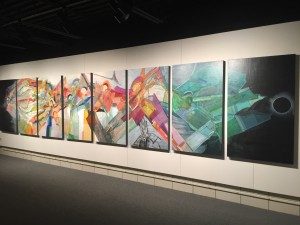 September 21 – October 16
September 21 – October 16
Reception: September 20, 2 – 4pm
Artist Nikos Fyodor Rutkowski of Columbus exhibits Infinite Loop, an abstract, mixed media painting installation.
Artist Statement:
Life can lead us on wild tangents: our lives are a cumulative history of strange paths taken, tangled and interwoven relations. Couplings, relationships, uncouplings; people come into our lives and affect us in some way, and then disappear as suddenly as they arrived sometimes. Outside stimulus, new knowledge and scientific discoveries creep in and act upon our lives and understanding of our world. Addictions, afflictions, interests are all cultivated and developed. Our lives, no matter how individual and unique, echo the lives of others. Our cycles as individuals echo other cycles. Narrative structure. Evolution. Development of styles, fads. Everything cycles through.
The birth of my son near the end of 2013 has profoundly affected my thinking on life and art. He has prompted me to think deeply about my own life, my evolution as a person and as an artist. His arrival has made me ponder my place in a continuum in a way that I never had before. As an artist, as a painter, there had always been a burden of awareness hovering over me, a burden of concern over the relevance of what I’m doing and whether it fits a narrative of art history or not. And that has been mostly supplanted by thinking of issues outside of art. It has pushed down aesthetic thinking into a more intuitive mode for me.
After what I can only describe as an unintentional hiatus from painting for a couple of years, I made the decision to make the largest painting of my career. By my way of thinking it’s not so much ambitious as absolutely needed. The outlet had been stopped up for so long that I needed the maximum amount of space possible to unleash everything that had been building up.
I’ve pinned this work upon the bones of two overlapping concepts. The first is the concept of a cyclical, repeating movement: the painting loops back upon itself and does not have a beginning nor an end. The second is the concept of an abstract work functioning as a narrative. To that end I have tried to find visual evocations of story structure, the phases of a life, the stages of a style: birth, life, and death equivalencies. And then rebirth, or continuation.
Artist Interview:
What is unique about your process and how does this define your practice?
My approach to creating art is based in a revelation that I had as a much younger man: that for me all materials and mediums are equal, and that nothing should be off the table as far as what to use. No material should be treated as if it were precious. I believe in an equality of materials. A cheap restaurant crayon for kids making marks on the back of a place mat should be used with the same attitude as gold leaf and fine Dutch oil paints on linen. This has also led to a respect for materials and their capabilities, and a better understanding of what they can and cannot do. I also tend to incorporate “craft ghetto” materials like glitter, glow in the dark paint, and day-glow colors into my work.
My process involves never relying on sketches or preliminary studies because in my mind those are their own unique art pieces. I also find there to be a huge disconnect in trying to reproduce something from, say, a hard medium like graphite to a more fluid medium like paint; something is always lost in translation.
Because of my view of medium equality and “medium specificity” my paintings are very layered, filled with erasures, overlays, washes, and other collage and painting techniques. What many artists would rectify in sketches or studies ahead of time, I do on the surface of the finished piece.
I would not call myself a formalist, but it is the easiest point of access to my work. Aesthetic issues are always of the foremost consideration in my paintings.
What influences your work or your creative process?
As an artist in my mid-thirties it’s hard to exactly pinpoint my influences; however I hate to adopt a pose that I’m “beyond influences.” There are always those exhibits that shock your senses and make you rethink the work that you’re making, and make you consider for a moment mimicking their work. In the past decade or so I’ve had this experience in front of work by Julie Mehretu, Lee Bonteco and Mark Bradford specifically.
My earliest artistic influences would be Robert Rauschenberg, Willem de Kooning, Eva Hesse, Dieter Roth, and others (as an avid Art History aficionado I could keep going forever).
The biggest influence on my work beyond other artists is life itself. Having a very young son has opened me up to thinking about art in ways that I never would have before, and has allowed me to see with a new set of eyes.
What lessons have you learned from other artists?
The most important lesson I’ve learned from other artists is just how toxic most art supplies really are, and how to use them in a less brazenly reckless way than I did in my youth. Understanding the hazards that you’re exposing yourself to is profoundly profane.
